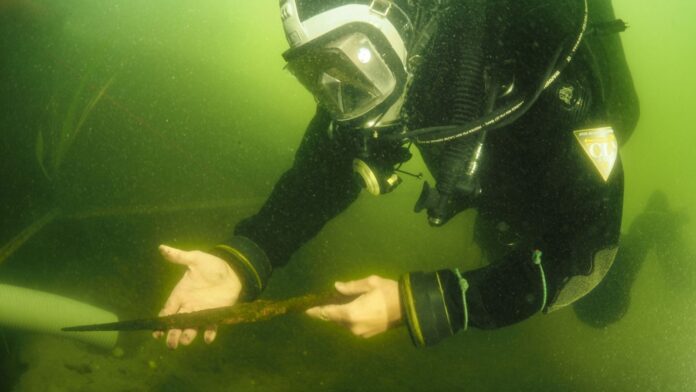Underwater archaeologists have recovered four medieval spearheads from Lake Lednica in Poland, including one lavishly decorated with gold, silver, and bronze. The discovery sheds light on both the warfare tactics and potential religious practices of early medieval Poland.
Unique Artifacts Reveal Social Hierarchy
One spearhead stands out due to its gilded and intricately decorated surface, featuring spiral and triskelion motifs alongside wing-like embellishments. This suggests the weapon belonged to a high-ranking individual, possibly a prince or nobleman. The spear’s design implies it was more a symbol of power than a practical weapon for battle.
Rare Preservation of Shafts
Remarkably, one of the spearheads remains attached to a 6.5-foot-long ash wood shaft, a rare find given that only two other spears from Lake Lednica have such well-preserved shafts. The spear also features an antler ring at its tip, further distinguishing it as a unique artifact. Another spearhead is notable for its slender, willow leaf-shaped design, a common form throughout early medieval Europe.
Advanced Forging Techniques
One spearhead was crafted using a welded technique, repeatedly forging soft and hard steels together. This advanced method produced a weapon with superior combat properties, representing the highest level of forging technology in medieval Europe.
Lake Lednica: A Medieval Armory
Lake Lednica has long been known for its wealth of medieval weaponry. Divers from Nicolaus Copernicus University have spent 40 years exploring the lake, recovering roughly 145 axes, 64 spearheads, and eight swords.
Theories Behind the Weapon Cache
The abundance of weapons in the lake remains a subject of debate. One prominent theory links the cache to the aftermath of King Mieszko II’s death in 1034, when invading Czech forces under Prince Bretislaus sacked nearby settlements. Weapons may have been lost during fighting on bridges and boats.
Another theory suggests the spears were ritual offerings to appease pagan deities during a period when Poland was transitioning to Christianity. Pagan practices persisted for centuries alongside the new religion.
Ongoing Research
Researchers are conducting macro X-ray fluorescence analysis to determine the spearheads’ chemical composition and trace their origins. The ongoing exploration of Lake Lednica promises to reveal further insights into medieval Poland’s warfare, social structures, and religious beliefs.
The discoveries underscore how archaeological sites can offer a unique window into the past, illuminating not just the tools of war, but the cultural and religious contexts that shaped them


































